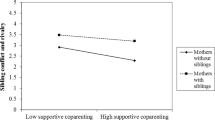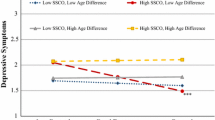Abstract
We examined the impact of family emotional climate and sibling relationship quality on behavioral problems and adaptation in preschool-aged children. Participants were 63 mothers with a preschool-aged child enrolled in a Southern Arizona Head Start Program. Siblings were identified as children closest in age to target child. Mothers of predominantly Mexican descent (95%) participated in home interviews during the Fall and Spring of the year children entered center-based programs. Sibling relationship quality (warmth, agonism/competition) was proposed to predict children’s adjustment (behavioral problems and adaptation) longitudinally. Results indicate that after controlling for child characteristics (temperament, child gender, birth order) and after accounting for family characteristics (family emotional expressiveness, child exposure to interparental conflict, and parental agreement on childrearing), sibling warmth made a significant and unique contribution to child adjustment as reported by mothers and teachers six months later. Findings are consistent with existing research indicating that sibling relationships impact children’s adjustment and shape young children’s lives in meaningful and marked ways. Moreover, these associations were found with an understudied sample of young children of predominantly Mexican descent in low-income families, and thus make an important contribution to knowledge in the field.
Similar content being viewed by others
References
Achenbach, T. M., & Rescorla, L. A. (2000). Manual for the ASEBA forms and profiles. Burlington, VT: University of Vermont Department of Psychiatry.
Buhrmester, D., & Furman, W. (1990). Perceptions of sibling relationships during middle childhood and adolescence. Child Development, 61, 1387–1398.
Brody, G. H. (1998). Sibling relationship quality: Its causes and consequences. Annual Review of Psychology, 49, 1–24.
Brody, G. H., Kim, S., & Murry, V. M. (2003). Longitudinal direct and indirect pathways linking older sibling competence to the development of younger sibling competence. Developmental Psychology, 39, 618–628.
Brody, G. H., Stoneman, Z., & McCoy, J. K. (1992). Associations of maternal and paternal direct and differential behavior with sibling relationships: Contemporaneous and longitudinal analyses. Child Development, 63, 82–92.
Brody, G. H., Stoneman, Z., McCoy, J. K., & Forehand, R. (1992). Contemporaneous and longitudinal associations of sibling conflict with family relationship assessments and family discussions about sibling problems. Child Development, 63, 391–400.
Brown, J. R., & Dunn, J. (1996). Continuities in emotion understanding from three to six years. Child Development, 67, 789–802.
Bryant, B. K., & Crockenberg, S. B. (1980). Correlates and dimensions of prosocial behavior: A study of female siblings with their mothers. Child Development, 51, 529–544.
Cervantes, C. A. (2002). Explanatory emotion talk in Mexican Immigrant and Mexican American families. Hispanic Journal of Behavioral Sciences, 24, 138–163.
Cummings, E. M. (1987). Coping with background anger in early childhood. Child Development, 58, 976–984.
Cummings, E. M., & Smith, D. (1993). The impact of anger between adults on siblings’ emotions and social behavior. Journal of Child Psychology and Psychiatry, 34, 1425–1433.
Dunn, J., Brown, J., Slomkowski, C., Tesla, C., & Youngblade, L. M. (1991). Young children’s understanding of other people’s feelings and beliefs: Individual differences and their antecedents. Child Development, 62, 1352–1366.
Dunn, J., Slomkowski, C., & Beardsall, L. (1994). Sibling relationships from the preschool period through middle childhood and early adolescence. Developmental Psychology, 30, 315–324.
Dunn, J., Slomkowski, C., Beardsall, L., & Rende, R. (1994). Adjustment in middle childhood and early adolescence: Links with earlier and contemporary sibling relationships. Journal of Child Psychology and Psychiatry and Allied Disciplines, 35, 491–504.
Dunn, J., Slomkowski, C., Donelan, N., & Herrera, C. (1995). Conflict, understanding, and relationships: Developments and differences in the preschool years. Early Education and Development, 6, 303–316.
Farver, J. M., & Howes, C. (1993). Cultural differences in American and Mexican mother-child pretend play. Merrill-Palmer Quarterly, 39, 344–358.
Furman, W., & Giberson, R. (1995). Identifying the links between parents and their children’s sibling relationships. In S. Shulman (Ed.), Close relationships and socioemotional development. Norwood, NJ: Ablex.
Garcia, M. M., Shaw, D. S., Winslow, E. B., & Yaggi, K. E. (2000). Destructive sibling conflict and the development of conduct problems in young boys. Developmental Psychology, 36, 44–53.
Grych, J. H., & Fincham, F. D. (1990). Marital conflict and children’s adjustment: A cognitive-contextual framework. Psychological Bulletin, 108, 267–290.
Halberstadt, A. (1986). Family socialization of emotional expression and nonverbal communication styles and skills. Journal of Personality and Social Psychology, 51, 827–836.
Howe, N. (1991). Sibling-directed internal state language, perspective taking, and affective behavior. Child Development, 62, 1503–1512.
Jouriles, E. N., Murphy, C. M., Farris, A. M., Smith, D. A., Richters, J. E., & Waters, E. (1991). Marital adjustment, parental disagreements about child rearing, and behavior problems in boys: Increasing the specificity of the marital assessment. Child Development, 62, 1424–1433.
Kramer, L., & Baron, L. A. (1995). Parental perceptions of children’s sibling relationships. Journal of Applied Family and Child Studies, 44, 95–103.
Kramer, L., & Gottman, J. M. (1992). Becoming a sibling: “With a little help from my friends.” Developmental Psychology, 28, 685–699.
Kramer, L., & Kowal, A. (2005). Sibling relationship quality from birth to adolescence: The enduring contributions of friends. Journal of Family Psychology, 19, 503–511.
LaFreniere, P. J., & Dumas, J. E. (1995). Social competence and behavior evaluation preschool edition (SCBE). Los Angeles, CA: Western Psychological Services.
Lockwood, R. L., Kitzmann, K. M., & Cohen, R. (2001). The impact of sibling warmth and conflict on children’s social competence with peers. Child Study Journal, 31, 47–70.
Marin, G., & Marin, B. V. (1991). Research with Hispanic populations. London: Sage.
McElwain, N. L., & Volling, B. L. (2005). Preschool children’s interactions with friends and older siblings: relationship specificity and joint contributions to problem behavior. Journal of Family Psychology, 19, 486–496.
McHale, S. M., Updegraff, K. A., Shanahan, L., Crouter, A. C., & Killoren, S. E. (2005). Siblings’ differential treatment in Mexican American families. Journal of Marriage and Family, 67, 1259–1274.
Minuchin, P. (1985). Families and individual development: Provocations from the field of family therapy. Child Development, 56, 289–302.
Mirande, A. (1977). The Chicano family: A reanalysis of conflicting views. Journal of Marriage and the Family, 6, 747–756.
Plomin, R., & Daniels, D. (1987). Why are children in the same family so different from one another? Behavioral and Brain Sciences, 10, 1–60.
Presley, R., & Martin, R. P. (1994). Toward a structure of preschool temperament: Factor structure of the Temperament Assessment Battery for Children. Journal of Personality, 62, 415–448.
Rende, R., & Plomin, R. (1995). Nature, nurture, and the development of psychology. In D. Cicchetti & D. Cohen (Eds.), Developmental psychopathology: Theories and methods, Vol 1. (pp. 291–314). New York: Wiley.
Ruiz, S. Y., Roosa, M. W., & Gonzales, N. A. (2002). American youths: A reexamination of the influence of parenting. Journal of Family Psychology, 16, 70–80.
Snyder, D. K. (1997). Manual for the marital satisfaction inventory—Revised. Los Angeles, CA: Western Psychological Services.
Stocker, C. (1994). Children’s perceptions of relationships with sibling, friends, and mothers: Compensatory processes and links with adjustment. Journal of Child Psychology and Psychiatry, 35, 1447–1459.
Stocker, C., Burwell, R., & Briggs, M. (2002). Sibling conflict in middle childhood predicts children’s adjustment in early adolescence. Journal of Family Psychology, 16, 50–57.
Stocker, C., Dunn, J., & Plomin, R. (1989). Sibling relationships: Links with child temperament, maternal behavior, and family structure. Child Development, 60, 715–727.
Triandis, H. C., Marin, G., Lisansky, J., & Betancourt, H. (1984). Simpatía as a cultural script of Hispanics. Journal of Personality and Social Psychology, 47, 1363–1375.
Volling, B. L., & Belsky, J. (1992). The contribution of mother-child and father-child relationships to the quality of sibling interaction: A longitudinal study. Child Development, 63, 1209–1222.
Zayas, L. H., & Solari, F. (1994). Early childhood socialization in Hispanic families: Context, culture, and practice implications. Professional Psychology: Research and Practice, 25, 200–206.
Acknowledgments
This research was funded by an ACYF University-Head Start Partnership grant, number 90-YD-0067. We greatly appreciate the contributions of the many faculty members, staff members, graduate students, and undergraduate students involved in this project, with special thanks to Jeong Jin Yu, M.S. We would also like to thank the many families whose participation helped to make this research possible.
Author information
Authors and Affiliations
Corresponding author
Rights and permissions
About this article
Cite this article
Modry-Mandell, K.L., Gamble, W.C. & Taylor, A.R. Family Emotional Climate and Sibling Relationship Quality: Influences on Behavioral Problems and Adaptation in Preschool-Aged Children. J Child Fam Stud 16, 59–71 (2007). https://doi.org/10.1007/s10826-006-9068-3
Published:
Issue Date:
DOI: https://doi.org/10.1007/s10826-006-9068-3




